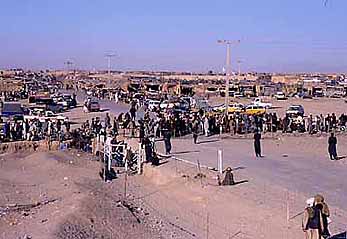UNHCR to begin helping Afghans return in late March
UNHCR to begin helping Afghans return in late March

More than 34,000 Afghan refugees returned home through Pakistan's Chaman border in January.
KABUL, Feb. 5 (UNHCR) - The United Nations High Commissioner for Refugees plans to provide returnee packages to some 250,000 Afghans during the next two to three months, but will not formally start repatriating refugees from Pakistan and Iran until late March at the earliest.
The agency expects to help some 800,000 of the more than 3.5 million Afghans currently in Iran and Pakistan return this year, Kris Janowski, a UNHCR spokesman, told a news briefing in Geneva Tuesday. He said the agency plans to assist another 400,000 internally displaced persons inside Afghanistan return to their home regions.
The returnee packages being distributed to spontaneous returnees over the next three months include plastic tarpaulins, blankets, ovens and other kitchen utensils. But the agency, which has consistently said that Afghanistan was not now ready to receive a massive influx of refugees, will not actively begin helping the refugees to return until late March.
"We are not planning to start organised repatriation programmes until probably late March," Janowski said.
Many Afghans, however, are not waiting for outside help to find their way back. Monitors for the refugee agency reported the return of more than 170,000 Afghans from Iran and Pakistan since November, with about 67,000 internally displaced persons going back to their home regions during the same period. About 48,000 of these returned to Kabul, the capital.
In January alone, more than 105,000 refugees spontaneously returned from Iran and Pakistan. Of these, more than 50,000 people crossed the Torkham border post in north-west Pakistan, with an additional 34,000 going back through the Chaman border crossing in southern Pakistan. Some 20,000 refugees in Iran went back through the Dogharoun-Islam Qala post.
The majority of those returning from Pakistan were Tajiks, 18 percent were Pashtuns, eight percent Hazaras, and six percent Turkmen, according to a UNHCR survey. The study showed that 61 percent of those going back headed for Kabul and the central region surrounding it, 21 percent went to the eastern region, and 18 percent returned to northern areas of the country.
Many Afghans, especially single men, are evidently anxious to return to their towns and villages and see what is left of their houses. Of the 20,000 refugees who returned from Iran last month, for example, 19,000 were adult males without families. As was the case for those returning from Pakistan, the vast majority, 61 percent, of those returning were Tajiks.
The situation around Afghanistan's principal western city of Herat continues to stabilise, Janowski said, but he added that the estimated 300,000 or more internally displaced persons in four camps around the city remained a problem. The agency is supporting the registration of the more than 150,000 refugees at the Maslakh site currently being carried out by the International Organization for Migration.









